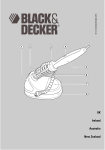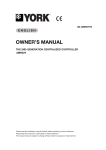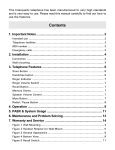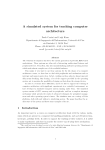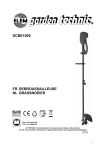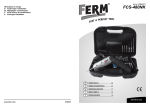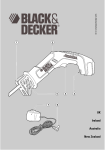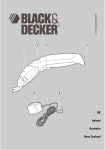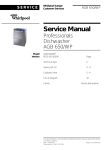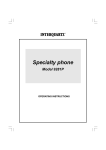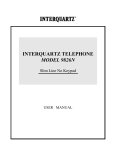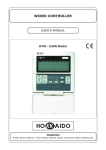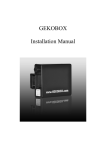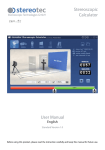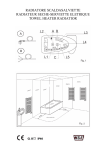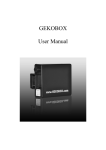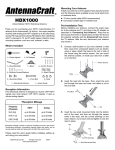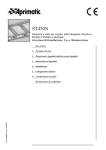Download dtco-uhxrv
Transcript
The 2nd-Generation Centralized Controller for Outdoor Units: DTCO-UHXRV Installation & Operation Manual Please keep this specifications Manual properly. Read this specifications Manual carefully before using the equipment. Table of Contents Centralized Controller DTCO-UHXRV Table of Contents PRESENTATION & PRECAUTIONS....................................................................................... 3 1. INSTALLATION........................................................................................................INST-1 2. USE OF THE EQUIPMENT.......................................................................................OPER-1 - Table of Contents - Presentation & Precautions Centralized Controller DTCO-UHXRV PRESENTATION & PRECAUTIONS Acknowledgments Thank you for your confidence in DTCO-UHXRV 2nd Generation Centralized Controller for Outdoor Units of “XRV Systems”. Use of this Specification Manual This specification Manual describes the installation of Centralized Controller and the conditions of operating it. For future reference, please keep this Manual properly after the device’s installation and testing. Available functions on DTCO-UHXRV device The functions which DTCO-UHXRV device is able to carry out also depend on the available functions on PCB of the Outdoor Units which belong to the systems to be controlled. The Outdoor Units must have on their Control PCB a “NIM” Module (”Network Interface Module”). Each Centralized Controller DTCO-UHXRV is able to control and monitor up to max. 32 Outdoor Units. Therefore, through DTCO-UHXRV it is possible the following: • To monitor the operation of the Outdoor Units that are connected to the signal network, therefore to immediately display the main operation parameters for each Unit, that is for example: fan speed, operation state of compressors, state of SV valves, opening of expansion valves (EXV), state of main 4-ways valve (ST1) and auxiliary 4-ways valve (ST2), automatic defrost, oil recovery from refrigerant circuit, instant energy consumption (kWh), pilot frequency of Inverter compressor, total number of Indoor Units connected to the Outdoor Unit, temperature on heat exchanger, outside air temperature, outlet temperature of compressors, current values of compressors. • To force operation mode to Cooling mode, so as to prevent Users from selecting a different operation - Presentation & Precautions - Presentation & Precautions Centralized Controller DTCO-UHXRV mode by using the Indoor Units’ remote controllers. • To allow the consumptions’ recording of each Outdoor Unit, so as to allocate easily and equitably the energy costs of air-conditioning systems. This function is available only in case of installation of the Electricity Absorption Detector on each Outdoor Unit whose consumptions you want to record. • To display the Error Codes referred to eventual Malfunctions and Protection Functions on the Outdoor Units connected to the Centralized Controller‘s signal network. Appearance and functions of DTCO-UHXRV device • This DTCO-UHXRV Centralized Controller is equipped with a LCD display, which is able to display simultaneously or in sequence a great amount of information. • The push-button panel is protected by a cover with simplified opening for access to buttons. • Moreover, on DTCO-UHXRV there is a Red LED, that indicates that the Centralized Controller is powered by the provided transformer. For further information and/or eventual explanations In case of doubt or whatever need referred to the operation of DTCO-UHXRV Centralized Controller, please contact the Dealer who provided the device and/or the air-conditioning systems. - Presentation & Precautions - Part 1: Installation Centralized Controller DTCO-UHXRV 1. INSTALLATION Note In the wiring diagrams in the following pages there is the RS-485 ↔ RS-232 Converter. However, this component and its wiring are required only in case the Control System is connected to a PC where the BMS-UHXRV Software Package has been installed. A PC can manage up to max. 16 DTCO-UHXRV Centralized Controllers and 16 DTC-IHXR Centralized Controllers; each DTCO-UHXRV can control and monitor up to max. 32 Outdoor Units, while each DTC-IHXR can control and monitor up to 64 Indoor Units. DTCO-UHXRV & DTC-IHXR Centralized Controllers on network differ from other controllers for the address (which cannot be duplicated) assigned to each one; for DTCO-UHXRV, you can assign an address in the range 16~31, while for DTC-IHXR, you can assign an address in the range 00~15 Safety Precautions Read carefully the Safety Precautions before installing the DTCO-UHXRV Centralized Controller. Stated below are important safety issues that must be obeyed. Safety Precautions are differentiated by the following marks, according to the possible consequences which may result in case the instructions are not observed. ! Warning Means improper handling may lead to personal injury or property loss. Note Means improper handling may lead to personal death or severe injury. Upon completion of the installation, check the correct operation of the DTCO-UHXRV Centralized Controller by carrying out the Trial Run of the device. Always deliver the User’s Manual to the User, and recommend him to keep it with care for future reference. ! Warning Please entrust the Distributor or the Authorized Technical Service to install the equipment. Installation by unauthorized persons may lead to imperfect installation which may result in electric shock or fire. INST-1 Part 1: Installation Centralized Controller DTCO-UHXRV To carry out correct installation of DTCO-UHXRV Centralized Controller, carefully observe this Manual. Improper installation may lead to electric shock or fire. In case DTCO-UHXRV device is removed and then reinstalled, it is necessary to observe the same instructions shown in this Manual for first installation. Improper reinstallation may lead to electric shock or fire. Do not uninstall DTCO-UHXRV device without the User’s permission. Before removing the equipment, it is necessary to configure again the Units and the other equipments of the Control System, otherwise the Units may run abnormally, the wiring may get overheated and lead to fire. Note Do not install the equipment in a place where leakage of flammable gas may occur. Once flammable gases are leaked and left around the Centralized Controller, fire may occur. Examples of wiring of DTCO-UHXRV in the Control System (Position of DTCO-UHXRV along the signal lines, as regards the Outdoor Units to be controlled and monitor. Both wiring diagrams proposed below are correct.) It is reminded that the number max. of Outdoor Units that can be controlled and monitored by each DTCO-UHXRV is 32. Example 1 Outdoor Unit Outdoor Unit Outdoor Unit Outdoor Unit Outdoor Unit Outdoor Unit Centralized Controller DTCO-UHXRV Example 2 Outdoor Unit Outdoor Unit Outdoor Unit Centralized Controller DTCO-UHXRV INST-2 Outdoor Unit Outdoor Unit Outdoor Unit Part 1: Installation Centralized Controller DTCO-UHXRV Packing box list Check whether the assemblies are complete: 1. Centralized Controller DTCO-UHXRV, with pre-wired power supply cable and bipolar female connector of proprietary type, quick clutch. 2. Phillips roundheaded metric screws M4 x 25 (3 pcs.), for fixing the Centralized Controller inside an electric box of commercial type. 3. Phillips roundheaded wood screws M4 x 20 (3 pcs.), for direct and on sight installation of Centralized Controller on the fixing surface. 4. Phillips roundheaded self-tapping screws M4 x 15 (2 pcs.), for eventual other kinds of fixing (example: sheet metal surfaces). 5. 120Ω ohmic resistance, pre-wired at both ends, to be installed at the ending and between the contacts “K1, K2” in the connection terminal block of DTCO-UHXRV (connection to the Outdoor Units to be controlled). 6, Current transformer for powering of DTCO-UHXRV, with bipolar male connector, quick clutch. Input voltage: 220V AC. Output voltage: 9.5V DC. 7. This Installation & Operation Manual. A BACK VIEW FRONTAL VIEW B • Dimensions of Centralized Controller: • Distances between fixing holes: - Height = 120mm. - A ↔ C = 85mm - Width = 120mm. - B ↔ C = 48mm - Depth = 20mm ~ 33mm. INST-3 C Part 1: Installation Centralized Controller DTCO-UHXRV M4 x 25 M4 x 15 120Ω M4 x 20 LENGTH OF CABLE: 1.7 METRES POWER CONNECTOR INST-4 Part 1: Installation Centralized Controller DTCO-UHXRV Installation assemblies, not included in the packaging (to be purchased on site) Before starting the installation, please purchase the following assemblies and material on site: 1. 3-core shielded cables, of necessary length and appopriate size according to the length required by installation, for the connection of DTCO-UHXRV to the Outdoor Units (signal lines “K1, K2, E”) to be controlled. The recommended min. size is of 1.0 mm2. 2. In case of several DTCO-UHXRV Centralized Controllers and of a PC provided with a BMS-UHXRV Software package (original software, and specific for “Building Management System”) and corresponding Hardware (RS-485 ↔ RS-232 Converter): 3-core shielded cables, of necessary length and appropriate size (the recommended size is of 1.0 mm2) according to the length required by installation, for the connection of DTCO-UHXRV devices each other (signal lines “F1, F2, E”) and for the connection between the first DTCO-UHXRV and RS-485 ↔ RS-232 Converter. 3. Embedded or at sight electric boxes, according to the quantity required by installation (depending on the number of DTCO-UHXRV Centralized Controllers), and provided with screw joints, watertightness. 4. Plastic hard pipes for electric wires, whose total length is able to satisfy installation requirements. 5. Nylon clamps for electric wires, whose quantity is able to satisfy installation requirements. Connection of DTCO-UHXRV to the power transformer (provided) 1. DTCO-UHXRV is powered by the power transformer included in the packaging. 2. The output voltage of transformer is 9.5V DC. The input voltage of transformer is 220V AC. 3. The length of the output power cable of transformer is of 1.7m. It is recommended not to make junctions on the cable to extend its length. Therefore, when the installation position of DTCO-UHXRV is selected, it is necessary to take into consideration the length of cable. 4. At the end of the output cable of transformer, there is a bipolar male connector of proprietary type, quick clutch. It must be connected to the corresponding female connector, pre-wired on DTCO-UHXRV, as it is shown in the following page. 5. The clutch between the connectors foresees a security system composed of 2 pressure side tabs, INST-5 Part 1: Installation Centralized Controller DTCO-UHXRV so as to prevent the accidental disconnection of wiring. Centralized Controller DTCO-UHXRV Power transformer Input: 220V AC / Output: 9.5V DC 2-pole Power Supply Connectors Addressing of each DTCO-UHXRV, in the signal network 1. Each DTCO-UHXRV Centralized Controller can control up to max. 32 Outdoor Units. 2. On the same signal network, there can be up to max. 16 DTCO-UHXRV Centralized Controllers, provided that a different address is assigned to each Centralized Controller: the same address must not be assigned to two different DTCO-UHXRV Centralized Controllers. 3. The addressing (variable from “16” to “31”: the default address is “16”) is carried out by pressing repeatedly with a pointed article the “ADDRESS” microswitch (see the Figure below), until in the standby screen - down on the right - the desired address is displayed. “ADDRESS” microswitch INST-6 Part 1: Installation Centralized Controller DTCO-UHXRV 4. Each time “ADDRESS” button is pressed - with a pointed article -, the address assigned to DTCO-UHXRV increases by steps of one Unit, according to the sequence shown below: 16 → 17 → 18 → 19 → 20 → 21 → 22 → 23 → 24 → 25 → 26 → 27 → 28 → 29 → 30 → 31 Assigned Address = “16” (factory default setting) Addressing of the Outdoor Units as regards DTCO-UHXRV Centralized Controller In order that each Outdoor Unit can be correctly recognized in the signal network and controlled by DTCO-UHXRV, it is necessary that it is previously “addressed” (by the assignation of one number in the signal network), as regards DTCO-UHXRV. To that end, on the Control PCB of the Outdoor Unit there are the following hardware assemblies: • “S2” battery composed of 2 microswitches: each of them can be set to “ON” or to “OFF”, in order to obtain the 2 only useful combinations for the addressing. The combination of the 2 microswitches bounds the ends of the addresses’ range which can be assigned by S3 rotary selector (see the following item and the Table in the following page). • “S3” rotary selector, with 16 positions, that can be set from “0” to “F”, for the assignation of an address number to the Outdoor Unit as regards DTCO-UHXRV Centralized Controller for Outdoor Units. If “S3” rotary selector is used in combination with S2 - battery composed by 2 microswitches - allows to cover an address range from “00” to “31”. INST-7 Part 1: Installation Centralized Controller DTCO-UHXRV Before using a Centralized Controller for Outdoor Units, and before using BMS-UHXRV software application, the addressing procedure of the Outdoor Units as regards the Centralized Controller must have been necessarily completed. Each Outdoor Unit must have a different address as to the other Outdoor Units controlled by the same DTCO-UHXRV Centralized Controller. Selectors for the addressing of the Outdoor Unit as regards the Centralized Controller S2 S3 da “0” fino a “F” 00 ~ 15 ~ S2 S3 Limits of the address range (S2) da “0” fino a “F” ~ 16 ~ 31 Note. Whatever combination of “S2” microswitches which is different from those represented in the Table, is not correct. INST-8 Part 1: Installation Centralized Controller DTCO-UHXRV Basic conditions of installing the Centralized Controller Please observe the following basic conditions to carry out a professional installation of DTCO-UHXRV: 1. Connect the power transformer to the nearest power socket. 2. Do not lay the power cables of the Outdoor Units by inserting them inside the same plastic hard wire pipe, used for the signal cables (“K1, K2, E”) (“F1, F2, E”). Insert the power cables and the signal cables in two different hard wire pipes and keep a distance of at least 0.5 metres between the pipes. 3. The signal cables of DTCO-UHXRV Centralized Controller shall not exceed 1200m. 4. No intermediate joint is allowed for the shielded signal cable. If joints are inevitable, crimp them with the terminal. 5. After the Centralized Controller is connected to the signal cables, it is no more possible to inspect insulation between each wire of signal cables. 6. Wiring mode for connection between the Centralized Controller and the “NIM” Module (”Network Interface Module”) of Outdoor Units to be controlled. On this point, Installers are reminded that the signal lines “K1, K2” (between DTCO-UHXRV and the nearest Outdoor Unit, and among the Outdoor Units) are polarized, therefore they should correspond properly at both sides. Do not cross-connect cables (see the Figure below). The same principles apply to “F1, F2” signal lines between the DTCO-UHXRV Centralized Controllers and between the first DTCO-UHXRV and the RS-485 ↔ RS-232 Converter - supplied with the BMS-UHXRV Software Package - for control and monitoring by PC. • WRONG connection • CORRECT connection K1 K2 E E E K1 K2 E K1 K2 K1 K2 • WRONG connection • CORRECT correction F1 F2 E E E F1 F2 E F1 F2 F1 F2 INST-9 Part 1: Installation Centralized Controller DTCO-UHXRV Installation procedure The installation of DTCO-UHXRV Centralized Controller may take place directly on the fixing surface or inside a special electric box (embedded or on sight installation). • The size of the signal wires to be conncected to DTCO-UHXRV depends on the length of the signal lines. The recommended min. size is of 1.0 mm2. The max. length is of 1200m. • Lay the Centralized Controller’s cables inside a plastic hard wire pipe, of appropriate dimension. Never lay in the same pipe the signal cables and the power cables. • Remove the frontal panel of DTCO-UHXRV by inserting the point of a flathead screwdriver in the hollows on the upper part of the device. Slightly rotate to separate the frontal panel from the back cover of DTCO-UHXRV (see the Figure below). For the details about the removal of the frontal panel and the connections to the terminal blocks, please refer to the Figures below and to the following page. Opening of the device & installation assemblies Hollows on the upper part (insert a screwdriver for opening) Back cover Front cover Display LCD Push-button panel Terminal bock for the signal lines (leave a space for cables) Lid Mounting screws (M4 x 25) on the electric box, or fixing screws (M4 x 20) Notes. 1. The central Figure shows the position of the 3 fixing holes, on the back cover. 2. For the le dimensions of DTCO-UHXRV and the distances between the fixing holes, please refer to the Figures on page INST-3. INST-10 Part 1: Installation Centralized Controller DTCO-UHXRV Total view of DTCO-UHXRV’s connections Signal Lines Power Supply Terminal block for the connection of signal lines (on the back of DTCO-UHXRV) K1, K2, E: F1, F2, E: Communication lines with other eventual DTCO-UHXRV Centralized Controller and with the PC (connection to RS-485 ↔ RS-232 Converter, provided with BMS-UHXRV) that manages the Control System. INST-11 Communication lines of DTCO-UHXRV with the Outdoor Units that are equipped with a “Network Interface Module” (“NIM”). Part 1: Installation Centralized Controller DTCO-UHXRV Wiring 1: DTCO-UHXRV Centralized Controllers for Outdoor Units + DTA-IHXR Time Wattmeter Outdoor Units Notes: 1. The power lines of each Outdoor Unit must be connected at first to DTA-IHXR Digital Ammeter, and then to the power terminal block of Outdoor Unit. The cable size for the power lines depends on the capacity of the Outdoor Unit. 2. Each Centralized Controller for Outdoor Units can control up to 32 Outdoor Units. 120Ω AB CN 9 O A AB CN AB CN 6 Power supply 3 6 9 4 7 4 7 380~415V, 3Ph, 50Hz 1 3 4 7 N 6 9 4 7 AB C N 380~415V, 3Ph, 50Hz N 380~415V, 3Ph, 50Hz Outdoor Units 120Ω AB CN 3 6 9 3 4 7 4 7 N 4 N L N Power Supply(220V) K1 K2 E F2 F1 Connections among O.U. Connections Control Network Centralized Controller No.16 for Outdoor Units (DTCO-UHXRV) AB CN 10 3 7 6 9 10 I II DTA-IHXR 1 AB C 380~415V, 3Ph, 50Hz O A AB CN DTA-IHXR 1 AB C 380~415V, 3Ph, 50Hz 9 Power supply I II DTA-IHXR 1 AB C 6 I II DTA-IHXR 1 O A AB CN 10 I II K1 K2 E E H2 H1 E H2 H1 AB CN AB CN 10 K1 K2 E Power supply Secondary Outdoor Unit (1) O A AB CN AB CN 9 Power supply Main Outdoor Unit (No.X) K1 K2 E E H2 H1 E H2 H1 O A Secondary Outdoor Unit (1) Main Outdoor Unit (No.10) K1 K2 E 6 Centralized Controller No.1 for Outdoor Units (DTCO-UHXRV) 10 120Ω 3 Connections among O.U. Connections Control Network I II Notes: 1. The power lines of each Outdoor Unit must be connected at first to DTA-IHXR Digital Ammeter, and then to the power terminal block of Outdoor Unit. The cable size for power lines depends on the capacity of the Outdoor Unit. 2. Each Centralized Controller for Outdoor Units can control up to 32 Outdoor Units. Power supply K1 K2 E F2 F1 DTA-IHXR 1 AB C 380~415V, 3Ph, 50Hz L N Power Supply(220V) AB CN 10 DTA-IHXR AB C N 9 O A I II DTA-IHXR 1 AB C 6 I II DTA-IHXR 1 3 Power supply AB CN AB CN 10 I II K1 K2 E E H2 H1 E H2 H1 O A AB CN AB CN 10 K1 K2 E Power supply Secondary Outdoor Unit (1) K1 K2 E E H2 H1 E H2 H1 O A Main Outdoor Unit (No.2) K1 K2 E Power supply Secondary Outdoor Unit (1) Main Outdoor Unit (No.1) 120Ω 3 To RS-485 ↔ RS-232 Converter (and to other Centralized Controllers) 4 7 AB C N 380~415V, 3Ph, 50Hz N 380~415V, 3Ph, 50Hz Notes. 1. The signal lines “P, Q, E” (between the Indoor Units and the Outdoor Unit), “X, Y, E” (among the Indoor Units, and between the Indoor Units and the Centralized Controller for Indoor Units), “H1, H2, E” (among Outdoor Units installed in combination each other), “K1, K2, E” (among the Outdoor Units, and between the Outdoor Units and the Centralized Controller for Outdoor Units), “F1, F2, E” (between the Personal Computer for “Building Management System”, and the Centralized Controllers for Indoor/Outdoor Units), require the use of shielded cables having a min. size of 1.0mm2. All wiring has a polarity that must correspond properly. During installation, do not cross-connect cables. The max. allowed length for each signal line is of 1000m. 2. For the survey of the electric consumptions of a given Outdoor Unit, it is necessary a further connection (“O”, “A” lines) between the Outdoor Unit and the optional device DTA-IHXR (“Digital Ammeter”), specific only for that Outdoor Unit. 3. Each Personal Computer, through BMS-UHXRV Package, can manage up to max. 16 Centralized Controller for Outdoor Units. Each Centralized Controller for Outdoor Units can control up to 32 Outdoor Units. 4. The parallel installation of 120Ω resistances at each end of signal lines (see the diagram above) is no more strictly required, as in the meantime the capacity of anti-interference of the integrated control firmware in the Units (in the EEPROM) has improved. INST-12 Part 1: Installation Centralized Controller DTCO-UHXRV Wiring 2: DTC-IHXR Centralized Controllers for Outdoor Units and connection to Personal Computer Wiring between the Indoor Units and the Centralized Controllers Serial Connector RS232 (to be connected to PC) 120Ω ; < ( PCB RS485 ↔ RS232 Converter (supplied with BMS-UHXRV) ; < ( PCB NFM Indoor Unit No. 1 ; < ( PCB NFM Indoor Unit No. 2 NFM Indoor Unit No. 3 F1 F1 F2 F2 E 120Ω To other Centralized Controllers N L Alimentazione (220V) per C.C. DTC-IHXR E F2 F1 Al personal Computer e ad altri C.C. DTC-IHXR E Y ; < ( X PCB Alle Unità Interne da controllare ; < ( PCB NFM Indoor Unit No. 64 NFM Indoor Unit No. 63 ; < ( PCB NFM Indoor Unit No. 62 Wired Controller Centralized Controller No.1 for Indoor Units 120Ω ; < ( PCB ; < ( PCB NFM Indoor Unit No. 1 ; < ( PCB NFM Indoor Unit No. 2 NFM Indoor Unit No. 3 120Ω N L Alimentazione (220V) per C.C. DTC-IHXR E F2 F1 Al personal Computer e ad altri C.C. DTC-IHXR E Y ; < ( X Alle Unità Interne da controllare PCB NFM Indoor Unit No. 64 ; < ( PCB NFM Indoor Unit No. 63 ; < ( PCB NFM Indoor Unit No. 62 Wired Controller Centralized Controller No.16 for Indoor Units Notes: 1. The signal lines: “X, Y, E” (between the Indoor Units, and between the Indoor Units and the Centralized Controller for Indoor Units), “F1, F2, E” (between the PC for “Building Management System”, and the Centralized Controllers for Indoor/Outdoor Units), require the use of shielded cables with min. size of 1.0mm2. Both sides of these wires should correspond properly. During installation, do not cross-connect cables. The max. allowed length for each signal line is of 1200m. 2. Each Personal Computer, through the BMS-UHXRV Package, can manage up to max. 16 Centralized Controllers for Indoor Units. Each Centralized Controller for Indoor Units can control up to max. 64 Indoor Units. 3. The parallel installation of 120Ω resistances at each end of signal lines (see the diagram above) is no more strictly required, as in the meantime the anti-interference capacity of the control firmware inside Units (in the EEPROM) has been improved. INST-13 Part 2: Use of the Equipment Centralized Controller DTCO-UHXRV 2. USE OF THE EQUIPMENT Operative conditions for the use of DTCO-UHXRV device It is recommended to use the DTCO-UHXRV equipment only if there are the following requirements for its correct operation: 1. Power supply specifications of the device. Input voltage: 1-Phase, 220 ~ 242V AC. Input power supply frequency: 50/60Hz. 2. Operating environment temperature for a correct operation of the device: - Temperature range: -15°C ~ 43°C. - RH conditions in the installation site: 40% ~ 90%. Organization of the information contained in this Manual In the following pages, the following matters will be treated in depth: (1) Composition & Structure of Network Control System for air-conditioning installations. (2) Keywords & General Function Description. (3) Detailed description of electric control functions of Centralized Controller. (4) Tables of Error and Protection Codes shown by DTCO-UHXRV’s display. (4) Corresponding rules for Electromagnetic Compatibility (EMC) & Safety. OPER-1 Part 2: Use of the Equipment Centralized Controller DTCO-UHXRV (1) Composition & Structure of Network Control System for air-conditioning installations. 1. The DTC-IHXR device allows to carry out the Centralized Control of the operation and Monitoring of Indoor Units (query about some operating parameters, regular operating status, malfunctions, etc.), provided that DTC-IHXR and the Indoor Units are connected each other in a signal network. 2. The DTC-IHXR Centralized Controller can be connected to a PC (which must be equipped by a special Software), and by the PC it may interface with a Gateway (Lonworks® or BACnet®), thus belonging to a “BMS” System (“Building Management System”): therefore, the DTC-IHXR device carries out the Centralized Control and the Monitoring of the air conditioners. In this way, the air conditioners can be remote controlled, by reaching the PC and consequently the Control System even outside the building, through a WAN (“Wide Area Network”, therefore also by connecting to the PC by Internet), thus exceeding the limits set by the signal lines’ max. length. 3. The interactive mode between the “Master” device ↔ “Slave” device - which occurs when there is a hierarchy between hardware components - also applies to the communication between the DTC-IHXR Centralized Controller and the Indoor Units, and between the PC and the DTC-IHXR. In particular, inside the LAN (“Local Area Network”) made up of the DTC-IHXR and of the Indoor Units, the DTC-IHXR device is the Primary Equipment (“Master”), while the Indoor Units represent the Secondary Equipment (“Slave”). In the same way, inside the LAN (“Local Area Network”) made up of the PC and of the DTC-IHXR Centralized Controller, the PC is the Primary Equipment (“Master”), while the DTC-IHXR device is the Secondary Equipment (“Slave”). The Figure in the following page is a simplified representation of the Control System previously described. If one or several Indoor Units do not have a “X, Y, E” terminal block for the connection to the Control System, that is if the PCB does not have a “NIM” Module (“Network Interface Module”), it will be necessary to purchase separately this network interface, which is available as optional accessory (NIM-GRH). OPER-2 Part 2: Use of the Equipment Centralized Controller DTCO-UHXRV Overall view of Control System Indoor Units Network Interface Centralized Controller DTC-IHXR Personal Computer (with BMS-UHXRV) Note: The Network Interface may be already integrated on the Indoor Unit’s PCB, otherwise it must be bought separately as an optional accessory (NIM-GRH). World Wide Web (Internet) Up to max. 64 Indoor Units each DTC-IHXR Up to max. 16 DTC-IHXR on the signal network OPER-3 Part 2: Use of the Equipment Centralized Controller DTCO-UHXRV (2) Keywords & general function description. 2.1 What happens when DTCO-UHXRV is powered. When DTCO-UHXRV is powered and the current transformer (that functions as a power supplier) is connected to the network, for 3 seconds the display LCD of DTCO-UHXRV shows all indications that can be displayed. At the end of this interval, standby’s screen appears, which displays the following information: - Number of “Modules”, that is of Outdoor Units, and number of Installations (in case of Outdoor Units that are installed in combination each other, each installation is composed of min. 2 “Modules” up to max. 4 “Modules”) which are powered and connected (“On line” is displayed) to the Centralized Controller’s signal network and which are recognized by DTCO-UHXRV (necessary condition: the Outdoor Units must be expressly and correctly addressed as regards DTCO-UHXRV). Concerning the addressing procedure of Outdoor Units, please refer to “Part 1: Installation” of this Manual. - Number of address (below on the right) assigned to DTCO-UHXRV. 2.2 Address setting method of DTCO-UHXRV, in case of several devices on the same signal network. In the presence of a Personal Computer equipped with a special Software (and eventually interfaced by a Gateway Lonworks® or BACnet® to control networks of another kind), on the same signal network there can be up to max. 16 DTCO-UHXRV equipments. In the structure for the centralized control of the Outdoor Units, each DTCO-UHXRV is usually dedicated to the Outdoor Units that are installed in a given area of the building. An address is assigned to each DTCO-UHXRV - in the range 16 ~ 31 - to distinguish it from the other DTCO-UHXRV equipments; the address setting method is carried out as it has been previously described in “Part 1: Installation” of this Manual. 2.3 LED LED (status LED) on DTCO-UHXRV. If the Red LED is ON, this means that DTCO-UHXRV is powered by the electric network, through the special current transformer. OPER-4 Part 2: Use of the Equipment Centralized Controller DTCO-UHXRV 2.4 Lock of DTCO-UHXRV’s buttons. In order to avoid to press unintentionally any button on DTCO-UHXRV Centralized Controller, it is possible to lock the push-button panel, by pressing with a pointed article the special “LOCK” button when standby’s screen is displayed. If lock function is operating, the indicator To cancel lock function, press “LOCK” button again. The indicator is displayed. will disappear from the display. 2.5 Lock of Cooling mode by DTCO-UHXRV. If a special option is activated (called “Forced Cooling”), it is possible to prevent from selecting - by the Indoor Units’ remote controller - any operation mode incompatible with the Cooling mode. If this happens, the Indoor Unit will work in Fan only mode. However, if “Forced Cooling” option is activated on DTCO-UHXRV, the operation mode of one or several Indoor Units can be changed by using a DTC-IHXR Centralized Controller for Indoor Units (present on the signal network). In this case, the operation settings that have been selected by DTC-IHXR take the priority over “Forced Cooling” function activated on DTCO-UHXRV. 2.6 Display of Outdoor Unit‘s instant consumption by DTCO-UHXRV. In “QUERY” mode (see further on), among the parameters that can be displayed on each Outdoor Unit controlled by DTCO-UHXRV, there is also the instant electric consumption, expressed in kWh. This parameter can be displayed if an Electrical Input Detector DTA-IHXR specific for that Outdoor Unit is installed. OPER-5 “SET” button “QUERY” button “MODE” button “ADDRESS” button “OK” button “LOCK” button “PREVIOUS” & “NEXT” buttons PUSH-BUTTON PANEL OF DTCO-UHXRV CENTRALIZED CONTROLLER “PAGE UP/DOWN” buttons Centralized Controller DTCO-UHXRV Part 2: Use of the Equipment (3) Detailed specification of parts & functions of the equipment. 3.1 Outline of DTCO-UHXRV’s buttons- OPER-6 Part 2: Use of the Equipment Centralized Controller DTCO-UHXRV “QUERY” button If you press “QUERY” button, you can enter “QUERY” mode about the operating state of the controlled Outdoor Units. As default setting, the information are displayed about the Outdoor Unit “On line” (that is powered, connected to the signal network of Centralized Controller, and correctly addressed as regards DTCO-UHXRV) which has the lower number among those that have been assigned according to the control by the Centralized Controller. “PREVIOUS” button In “QUERY” mode, if you press “PREVIOUS” button, it is possible to display the operating parameters of the Outdoor Unit “On line” having the address number immediately previous as regards the Outdoor Unit currently displayed. If the Outdoor Unit currently displayed has the lower number among all Outdoor Units controlled by DTCO-UHXRV, if you press “PREVIOUS” button, the operating parameters of the Outdoor Unit having the higher number among all the Outdoor Units controlled by DTCO-UHXRV are displayed. “NEXT” button In “QUERY” mode, if you press “NEXT”, it is possible to display the operating parameters of the Outdoor Unit “On line” having the address number immediately following as regards the Outdoor Unit currently displayed. If the Outdoor Unit currently displayed has the higher number among all Outdoor Units controlled by DTCO-UHXRV, if you press “NEXT” button, the operating parameters of the Outdoor Unit having the lower number among all the Outdoor Units controlled by DTCO-UHXRV are displayed. “PAGE UP” button In “QUERY” mode, if you press “PAGE UP” button, it is possible to get to the screen that displays the operating parameter immediately previous, as regards the parameter currently displayed, OPER-7 Part 2: Use of the Equipment Centralized Controller DTCO-UHXRV for the Outdoor Unit previously selected. If the operating parameter currently displayed is the first in the list of the displayed parameters, if you press “PAGE UP” button, the last operating parameter in the list of the displayed parameters for the Outdoor Unit previously selected is displayed. “PAGE DOWN” button In “QUERY” mode, if you press “PAGE DOWN” button, it is possible to get to the screen that displays the operating parameter immediately following, as regards the parameter currently displayed, for the Outdoor Unit previously selected. If the operating parameter currently displayed is the last in the list of the displayed parameters, if you press “PAGE DOWN” button, the first parameter in the list of the displayed parameters for the Outdoor Unit previously selected is displayed. “SET” button If the equipment is not in “SET” mode yet, if you press “SET” button, you can select “SET” mode for setting the available options for the operation of the Outdoor Units “On line” controlled by DTCO-UHXRV. “MODE” button If the equipment is in “SET” mode, by pressing “MODE” button you can switch over - in a cyclic way - between the “Forced Cooling” option (that is: impossibilty to set, by the remote controllers of the Indoor Units which belong to the system, an operation mode incompatible with the Cooling mode) and the option “ ” (that is: no limit to the operation mode that can be selected by the Indoor Units’ remote controllers, except the restrictions which arise from the control logic inside the system). “OK” button After selecting, by “MODE” button (see above), between the option “Forced Cooling” option “ ”, it will be necessary to confirm the selection by pressing “OK” button. OPER-8 and the Part 2: Use of the Equipment Centralized Controller DTCO-UHXRV In case of successful operation, after 4 seconds, in the lower part and on the right of the display the indication is displayed. In case of unsuccessful operation, after 4 seconds, in the lower part and on the right of the display the indication is displayed. “LOCK” button In order to avoid to press unintentionally any button on DTCO-UHXRV Centralized Controller, it is possible to lock the push-button panel, by pressing with a pointed article “LOCK” button when standby screen is displayed. If lock function is operating, the indicator To cancel lock function, press “LOCK” button again; the indicator is displayed. will disappear from the display. “ADDRESS” button As it has been already seen in “Part 1: Installation”, on the same signal network there can be up to max. 16 DTCO-UHXRV Centralized Controllers, provided that only one address is assigned to each Centralized Controller (the same address must not be assigned to one or several DTCO-UHXRV Centralized Controllers). The address setting method (variable from “16” to “31”: the default address is “16”) can be carried out by pressing repeatedly this microswitch (“ADDRESS”), until in the lower part and on the right of the display’s screen, the desired address number is displayed. OPER-9 OPER-10 the displayed information will concern the actual operating conditions of the installations. The Figure shows all indicators and information that LCD is able to display. During the use of DTCO-UHXRV Centralized Controller, Note. DISPLAY OF DTCO-UHXRV CENTRALIZED CONTROLLER Centralized Controller DTCO-UHXRV Part 2: Use of the Equipment 3.2 Outline of indicators on DTCO-UHXRV’s display. Part 2: Use of the Equipment Centralized Controller DTCO-UHXRV 3.2.1 Indicators that can be displayed on ALL screens of display This indicator is displayed only if DTCO-UHXRV Centralized Controller is connected to a Personal Computer and eventually to a Gateway. If the connection is interrupted, the indicator will disappear from the display after 20 seconds. This indicator is displayed only if DTCO-UHXRV Centralized Controller is connected to the Outdoor Units (through the “NIM”, that is “Network Interface Module”; the module is integrated on the Control PCB of each Outdoor Unit). If the connection is interrupted, the indicator will disappear from the display after 20 seconds. This indicator is displayed in a dynamic and cyclic way (gradual switching on of the indicator, followed by full switching off, and so on), to indicate that communication between DTCO-UHXRV Centralized Controller and “NIM” Modules (see above) of the Outdoor Units occurs regularly. This indicator is displayed if Lock function of buttons on DTCO-UHXRV Centralized Controller is operating, that is after pressing “LOCK” button. The indicator disappears from the display if the function is cancelled, that is after pressing “LOCK” button again. OPER-11 Part 2: Use of the Equipment Centralized Controller DTCO-UHXRV 3.2.2 Indicators in “STANDBY” Page Display This indicator refers to the total number of “Modules” (in case of an installation composed of several Outdoor Units that are installed in combination each other, from a min. of 2 up to max. 4 Units, the indicator refers to each Outdoor Unit that belongs to the installation) which are “On line”, that is are powered, connected to the signal network of DTCO-UHXRV and correctly “addressed” for being controlled by the Centralized Controller. This indicator refers to the total number of installations (where each installation may also be composed of several Outdoor Units, called “Modules”, installed in combination each other) which are “On line”, that is are powered and connected to the signal network of DTCO-UHXRV, and where each Outdoor Unit of the installation is correctly “addressed” for being controlled by the Centralized Controlller. Display of the address number assigned to DTCO-UHXRV, in “STANDBY” In the lower part and on the right of “STANDBY” page display, as it is shown in the next photo, it is also displayed Indirizzo assegnato = “16” (impostazione di fabbrica) the address number assigned to DTCO-UHXRV in the signal network, for distinguishing it from other Centralized Controller, if they are available. As it has already shown previously, the address number assigned to DTCO-UHXRV in the signal network can be modified (in the range from “16” to “31”) by pressing repeatedly the “ADDRESS” button on the equipment, until the display shows the desired address number. The necessary condition is that DTCO-UHXRV is powered (Red LED: ON). OPER-12 Part 2: Use of the Equipment Centralized Controller DTCO-UHXRV 3.2.3 Indicators displayed in “SET” Page Display If this indicator is ON, this means that “SET” button has previously been pressed, and that the Centralized Controller is now in “SET” mode. This indicator refers to the address number of “Module” (in case of an installation composed of several Outdoor Units installed in combination each other, from a min. of 2 up to max. 4 Units, the indicator refers to each Outdoor Unit that belongs to the installation) which is currently selected, among the Modules that are “On line”. This indicator refers to the address of the Main Outdoor Unit in the Installation (in case of an installation composed of several Outdoor Units, calles “Modules”, installed in combination each other) which is currently selected among the Outdoor Units that are “On line”. Note. If you press “PREVIOUS” or “NEXT” button, it is possible to scroll respectively up and down the addresses of Outdoor Units’ “Modules” to which the settings available on the Centralized Controller can be applied. Example of possible setting in “SET” Mode If the equipment is in “SET” mode, by pressing “MODE” button you can change over - in a ciclic way - between the “Forced Cooling” option (that is: impossibility to set, by the remote controllers of the Indoor Units which belong to the installation, an operation mode incompatible with Cooling mode) and the option “ ” (that is: no limit to the operation mode that can be selected by the Indoor Units’ remote controllers, except the restrictions which arise from the control logic inside the system). After selecting, by “MODE” button, between “Forced Cooling” option “ ”, it will be necessary to confirm the selection by pressing “OK” button. OPER-13 and the option Part 2: Use of the Equipment Centralized Controller DTCO-UHXRV If the operation is successful, in the lower part and on the right of the display, the indication will be displayed after 4 seconds. If the operation is unsuccessful, the indication will be displayed after 4 seconds. Note. • The default page display of DTCO-UHXRV is “STANDBY” screen. If the Centralized Controller is in “SET” Mode (Setting) and no button is pressed for about 30 seconds, “STANDBY” screen is displayed again. OPER-14 Part 2: Use of the Equipment Centralized Controller DTCO-UHXRV 3.2.4 Indicators displayed in “QUERY” Page Display If this indicator is ON, this means that “QUERY” button has been previously pressed, and that the Centralized Controller is now in “QUERY” mode. This indicator refers to the address number of the “Module” (in case of an installation composed of several Outdoor Units installed in combination each other, from a min. of 2 up to max. 4 Units, the indicator refers to each Outdoor Unit that belongs to the installation) which is currently selected, among the “Modules” that are “On line”. This indicator refers to the address of the Main Outdoor Unit of the installation (in case of an installation composed of several Outdoor Units, called “Modules”, installed in combination each other) which is currently selected among the Outdoor Units that are “On line”. By pressing “PREVIOUS” or “NEXT” button, it is possible to switch over respectively up and down the addresses of the Outdoor Units “Modules” for which the query of the operating parameters can be carried out. This symbol indicates that the current operation mode of the system is the Cooling mode. This symbol indicates that the current operation mode of the system is the Heating mode. This symbol indicates that the current operation mode of the system is “OFF”, that is the compressor is not operating. OPER-15 Part 2: Use of the Equipment Centralized Controller DTCO-UHXRV This indicator is displayed when Lock function in Cooling mode is operating, for one or all Outdoor Units controlled by DTCO-UHXRV Centralized Controller. The indicator disappear from the display when Lock function is no more operating. This indicator is displayed when Lock function in Heating mode is operating, for one or all Outdoor Units controlled by DTCO-UHXRV Centralized Controller. The indicator disappears from the display when Lock function is no more operating. This indicator refers to fan speed on the selected Outdoor Unit. In this case, outdoor fan works at “LOW” speed. This indicator refers to fan speed on the selected Outdoor Unit. In this case, outdoor fan works at “MIDDLE” speed. This indicator refers to fan speed on the selected Outdoor Unit. In this case, fan speed works at “HIGH” speed. These indicators display the number of compressors which are operating now. These indicators display the number of soleinoid valves (“SV1 ~ 6”) which are ON. If this indicator is ON, this means that the main 4-ways valve (“ST1”) is on the position for operation in Heating mode. If this indicator is ON, this means that the Outdoor Unit’s auxiliary 4-way valve (“ST2”) is on the position for operation in Cooling mode in conditions of partial load. OPER-16 Part 2: Use of the Equipment Centralized Controller DTCO-UHXRV If this indicator is ON, this means that the automatic defrosting is in progress (reversal of refrigerant cycle from Heat to Cool). If this indicator is ON, this means that the procedure of compressors’ oil recovery from the refrigerant circuit is in progress. 3.2.5 Indications referred to the operating parameters in “QUERY” Page Display As it has already shown previously, by pressing “PREVIOUS” or “NEXT” button on DTCO-UHXRV, it is possible to switch over respectively up and down the addresses of the Outdoor Units’ “Modules” for which the query of the operating parameters can be carried out. After selecting the Outdoor Unit‘s “Module” for which the query can be carried out, the first page of the operating parameters that can be displayed will appear. In order to change over from one page to the following page or to the previous page, press respectively “PAGE UP” button (“Previous Page”) and “PAGE DOWN” button (“Following Page”). •Page 0 of operating parameters. If an Electrical Input Detector DTA-IHXR is connected to the Outdoor Unit to be queried, this page displays the information about the Outdoor Unit’s electric consumption, expressed in KWh. •Page 1 of operating parameters. This page displays the pilot frequency value of Inverter compressor on the selected Outdoor Unit, expressed in Hertz (Hz). OPER-17 Part 2: Use of the Equipment Centralized Controller DTCO-UHXRV •Page 2 of operating parameters. This page displays the total number of the Indoor Units “On line”, connected to the installations controlled by DTCO-UHXRV Centralized Controller. •Page 3 of operating parameters. This page displays “T3” temperature (temperature on heat exchanger), detected by the special sensor on the selected Outdoor Unit, and expressed in °C. •Page 4 of operating parameters. This page displays “T4” temperature (outside air temperature) detected by the special sensor on the selected Outdoor Unit, and expressed in °C. •Page 5 of operating parameters. This page displays the temperature value detected by “T6” sensor where it is available - , and expressed in °C. In “XRV Systems”, this temperature sensor is not available on the Outdoor Units, so the display will show the indication on the left (- - -). •Page 6 of operating parameters. This page displays the outlet temperature value which is detected on “Compressor 1” (Inverter compressor), and expressed in °C. OPER-18 Part 2: Use of the Equipment Centralized Controller DTCO-UHXRV •Page 7 of operating parameters. This page displays the outlet temperature value which is detected on “Compressor 2” (On/Off compressor), and expressed in °C. •Page 8 of operating parameters. This page displays the outlet temperature value which is detected on “Compressor 3” (On/Off compressor), and expressed in °C. •Page 9 of operating parameters. This page displays the input current value of “Compressor 1” (Inverter compressor), expressed in Ampères (A). •Page 10 of operating parameters. This page displays the input current value of “Compressor 2” (On/Off compressor), expressed in Ampères (A). •Page 11 of operating parameters. This page displays the input current value of “Compressor 3” (ON/Off compressor), expressed in Ampères (A). •Page 12 of operating parameters. On “XRV Systems”, this parameter is not available, so the display will show the indication on the left (- - -). OPER-19 Part 2: Use of the Equipment Centralized Controller DTCO-UHXRV •Page 13 of operating parameters. This page displays the opening angle of the electronic expansion valve “EXV1” on the selected Outdoor Unit. •Page 14 of operating parameters. This page displays the opening angle of the electronic expansion valve “EXV2” on the selected Outdoor Unit. •Page 15 of operating parameters. This page displays the Error Code referred to the most recent malfunction which is detected on the selected Outdoor Unit. or If there are no malfunctions, the display shows the indication on the left (- -). •Page 16 of operating parameters. This page displays the Protection Code referred to the intervention of the most recent protection function on the selected Outdoor Unit. If there is no intervention of protection functions, the display shows the indicatio on the left (- -). Notes. 1. The default page display of DTCO-UHXRV is “STANDBY” screen. If the Centralized Controller is in “QUERY” Mode, and no button is pressed for about 30 seconds, OPER-20 Part 2: Use of the Equipment Centralized Controller DTCO-UHXRV the display will show “STANDBY” screen again. 2. At each query of the Operating Parameters, in “QUERY” screen the first operating parameter will be the last operating parameter that was analyzed during the previous query. OPER-21 Part 2: Use of the Equipment Centralized Controller DTCO-UHXRV (4) Tables of Error Codes & Protection Codes displayed on DTCO-UHXRV. • Table of Error Codes Code Malfunction Contents EF Other kinds of malfunction (besides the malfunctions below). E4 Malfunction of temperature sensor T4 (outdoor air temperature). E3 Malfunction of temperature sensor T3 (Outdoor Unit’s heat exchanger). E2 Malfunction of temperature sensor on Inverter compressor’s discharge pipe. E1 Phase order error or phase loss. E0 Fault of communication between Outdoor Units (in combination each other). H3 Malfunction caused by a transitory increase in number of the connected Outdoor Units in combination (displayed only on Main Outdoor Unit). H2 Malfunction caused by a transitory reduction in number of the connected Outdoor Units in combination (displayed only on Main Outdoor Unit). H1 Fault of communication between the integrated control circuit for network connection and the integrated circuit for System Control. • Table of Protection Codes Code Protection Contents PF Other kinds of malfunctions (besides the malfunctions below). PE Procedure activation for oil balance between compressors. PD Procedure activation for oil return from refrigerant circuit. PA Intervention of a protection function during automatic defrosting. P8 Compressor Current 3rd Protection (On/Off compressor). P7 Compressor Current 2nd Protection (On/Off compressor). P5 Outdoor Unit’s heat exchanger High Temperature Protection (in Cooling mode). P4 Discharge Pipe High Temperature Protection (on On/Off compressor). P3 Compressor Current 1st Protection (Inverter compressor). P2 Discharge Low-pressure Protection. P1 Discharge High-pressure Protection. P0 Inverter Compressor High Temperature Protection. OPER-22 Part 2: Use of the Equipment Centralized Controller DTCO-UHXRV (4) Regulations for Electromagnetic Compatibility and Safety. 1. This DTCO-UHXRV Centralized Controller respects the Regulations for Electromagnetic Compatibility (EMC), Low Voltage Directive (LVD), and conforms with CE Standards (see CE Declaration of Conformity, in the following page). 2. This DTCO-UHXRV Centralized Controller respects the Regulations on the Safety of Electric Equipments: GB4706.32-2004 and GB/T7725-2004. OPER-23 Declaration Centralized Controller DTCO-UHXRV DECLARATION OF CONFORMITY We Srl - 14, Via della Salute - 40132 Bologna - Italy DECLARE UNDER OUR SOLE RESPONSIBILITY that Product “DTCO-UHXRV Centralized Controller” conforms to the following Directives: • Electromagnetic Compatibility Directive EMC 2004/108/EC. • Low Voltage Directive LVD 2006/95/EC. • Harmonized Rules: EN55014-1:2000+A1:2001+A2:2002 EN61000-3-2:2000, EN61000-3-3:1995+A1:2001 EN55014-2:1997+A1:2001 (Category II) EN60335-2-40:2003+A11:2004 EN50336:2003. - Declaration - Notes Centralized Controller DTCO-UHXRV Notes Notes-1 Notes Centralized Controller DTCO-UHXRV Notes Notes-2 HOKKAIDO Srl 14, Via della Salute - 40132 Bologna - Italy Ph. +39.051.41.33.111 Fax +39.051.41.33.146 www.hokkaido.eu Due to on-going technological development of Products by the Manufacturer, we reserve the right to vary the technical specifications at any time and without notice.












































